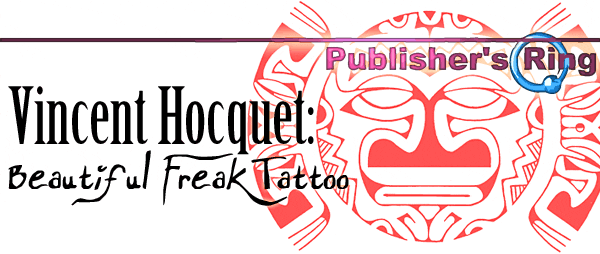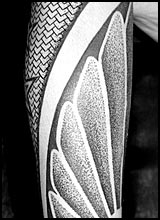|
When Vincent Hocquet was a child, he had an artist uncle who had a disability which prevented him from turning the palms of his hands up, forcing him to develop a unique way of painting and drawing. This uncle passed on his passion by starting little sketches for young Vincent to finish. Vincent also had an older cousin who was covered with tattoos which he emulated in marker all over his arms and legs. Then at fifteen he was inspired by the book Papillon by Henry Charriere to get his first tattoo. Finally, in 1996, he met David Kotker of No Hope, No Fear in Chicago who pushed him to invest in proper equipment and showed him how to build a machine. At the time, he was working at an antiques and art auction house, surrounded by a large variety of inspiring artwork, and a few months later he left to open his own studio. Soon he was tattooing four days a work both at Wildcat in Antwerp — where he worked with his girlfriend Peggy — and weekends at their own studio in St. Idesbald. They currently co-own and can be found at Beautiful Freak Tattoo (beautifulfreaktattoo.com).
BME: How did you meet David Kotker? I met David at the first tattoo convention I visited. He caught my attention because he was the only one not to have a bunch of flash books on the table and had nice photographs of his work instead. He also had a different attitude, and seemed more low profile. We started talking and his vision on tattooing was completely how I felt about tattoos. I decided to get tattooed by him and he asked me if I could help him out at some conventions. He recognized my interest in tattooing and that is why he motivated me to start tattooing. BME: You opened a studio fairly quickly — tell me about your early work? My first tattoos weren’t very good — it takes a while to get used to the techniques and to working on skin. My father offered to be my first customer. I made him a small tattoo on the arm, and he paid me one symbolic Belgian frank, which I still have as a lucky coin. We enlarged it to be a quarter sleeve a couple of years ago. My family is very supportive of what I do.
BME: Were you always doing this type of geometric dot work, or did you try other styles? I started trying out many styles to figure out what I was feeling most comfortable with. The Polynesian style always attracted me and I spent a lot of time on researching the origin and the symbolism of the old tribal arts. I tried to draw my own interpretation of it and started to put little stories in the designs, and hide many little elements in the design that are only seen when pointed out. I try to entangle the different elements into each other so they have unity. My daughter plays with them, using them as mazes. I started combining this Polynesian-inspired style with touches of dotwork, and it was a small step from there to making larger dotwork designs and patterns. BME: Did you apprentice? How did you learn? Like most tattooists, I did my first tattoos on my own legs. I never apprenticed but was lucky to get good advice from many good tattoo artists. These days, my thirteen year old daughter Naomi is a tough critic, and I get a lot of stimulus from doing other creative things. I do a lot of designing for projects that are not tattoo related. I’m also making music, drawing, cooking, painting, and I play with my two year old son. I think all of these indirectly help me in making better tattoos. I find that limiting myself to one category is limiting my general creativity. I also collect books and imagery from many forms of art, which help me feed my imagination.
BME: Who are your artistic influences? The artist I most look up to is M.C.Escher. I also like the prints of Masereel, and Bridget Riley’s work. David Kotker taught me not to work from flash, but to create my own designs. I like the works of Daniel, Xed, Tomas, and Pink.
BME: Who did your tattoos? I had work done by David Kotker from No Hope No Fear, Daniel from Calypso, Lutz from Artcore Ink, Tattoo Pink, Horitatsu from Dragon Tattoostudio, Robert from Clean Solid Tattoo, Marco Zopetti from Zoptattoo. Some of my tattoos I designed together with the artists, and for some I gave full liberty to the artist. BME: What are your favorite sorts of tattoos to do personally? I like the look of big and bold tattoos, but the process of a smaller, well thought out tattoo can be just as enjoyable. BME: When you’re putting on a large tattoo, how do you lay the stencil? Or do you freehand it? The bigger complex pattern work is done with different pieces of stencil in combination with freehanding. A lot of my other work I do is done freehand, as this is often easier to make the tattoo fit the body shape. BME: Do you tend to design by hand, or on a computer? The computer is a tool like a pencil or a compass — I only recently started working with the computer and this is a big time saver when it comes to making complex pattern work. I draw almost every tattoo by hand and made a habit of drawing every tattoo together with the customer, thus giving every customer a unique design. They love the process of starting off with a blank sheet of paper and seeing it evolve into a unique tattoo design in front of them.
BME: What do you think of the current popularity of tattoos? In the past, all you heard was that tattooing had to get more socially accepted and that people had to stop judging people with tattoos. Now that this is finally happening, the same people are complaining that tattooing isn’t “underground” anymore! I feel, the better tattooing is accepted in our society, the more blank canvasses are available to express our creativity. BME: Definitely, and a broader range of people come in for tattoos. Yes — a couple of years ago a sixty-five year old nun came in my shop and asked me for a tattoo. At first I thought it was a prank, but she was the real thing. I put an interpretation of the “agnus dei” on her shoulder blade. The tattoo took about two hours but afterwards we spent a whole evening discussing religion, music, the differences between our generations, and much more. She still visits me every year. These days you see more people getting big tattoos as a first tattoo, and people are more conscious about the different styles and possibilities. A lot of people are traveling to get tattooed by their favorite artists.
BME: Is tattooing something you’ll do forever? I probably will be tattooing as long as I can, but maybe I won’t do it forever to make a living. I still have other skills and ambitions I would like to develop and who knows where these will take me? BME: Do you just tattoo in Belgium, or do you travel as well? I have one guest spot I go to every year — the Dragon tattoo studio of Horitatsu in Kanuma, Japan. The cultural differences between our countries are very big. In Belgium I’ve never had a customer offering me dried squid as a first-meeting gift! I very much enjoy the subtle unspoken way of interacting socially and in business, and the good sense of humor. Vincent’s good friend Sam was the first person to let Vincent do a piece of this size on him. Their bodysuit project is now finished to the thighs, and they’re starting his arms this year. BME: Do you ever make mistakes in your geometric work? You must have to pay intense attention! I don’t make mistakes because I do indeed pay intense attention — I hardly make any conversation while doing these, and after a while the repetition of the work in combination with relaxing music in the background makes me feel like I’m doing mantras. Doing these tattoos brings me to a state of complete concentration and peace. BME: That’s definitely reflected in the pieces. Thank you for talking to us!
|
















 BME/News and Modblog highlight only a small fraction of what BME has to offer. Take our free tour and subscribe to BME for access to over 3 million body modification related photos, videos, and stories.
BME/News and Modblog highlight only a small fraction of what BME has to offer. Take our free tour and subscribe to BME for access to over 3 million body modification related photos, videos, and stories.